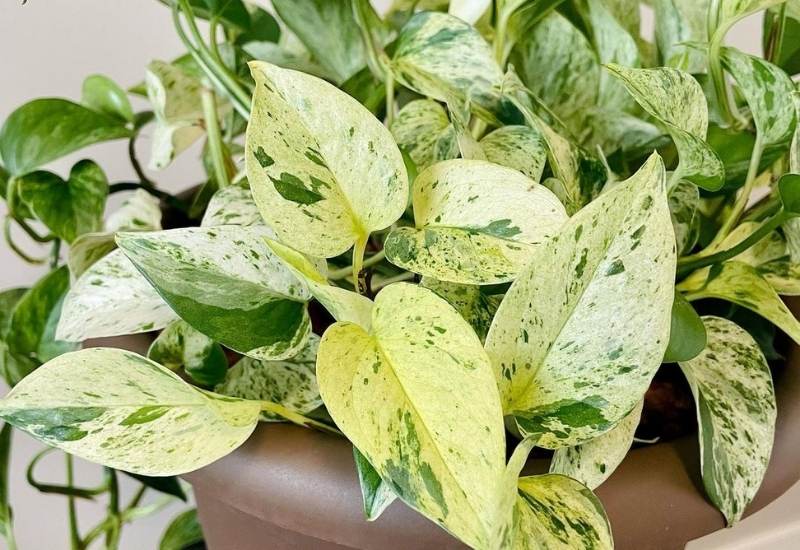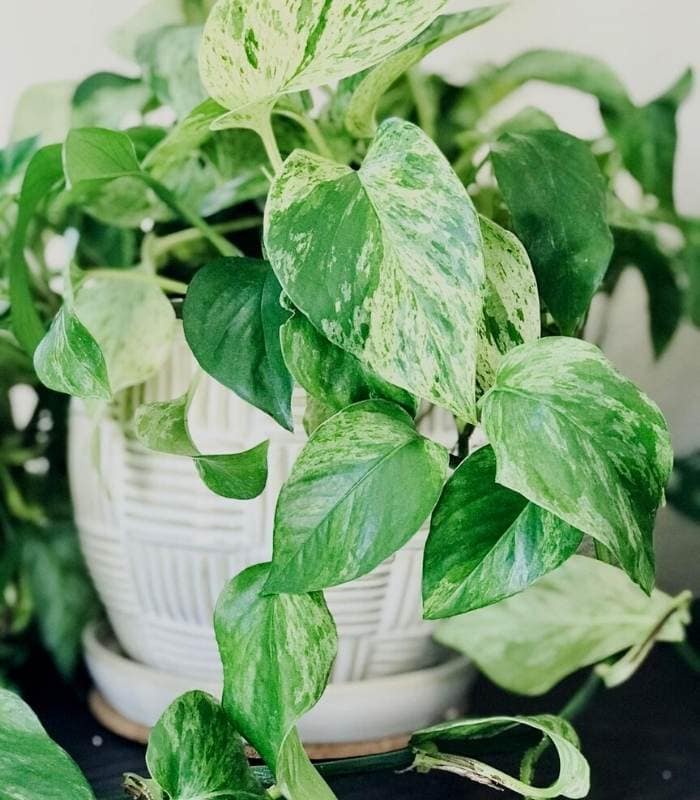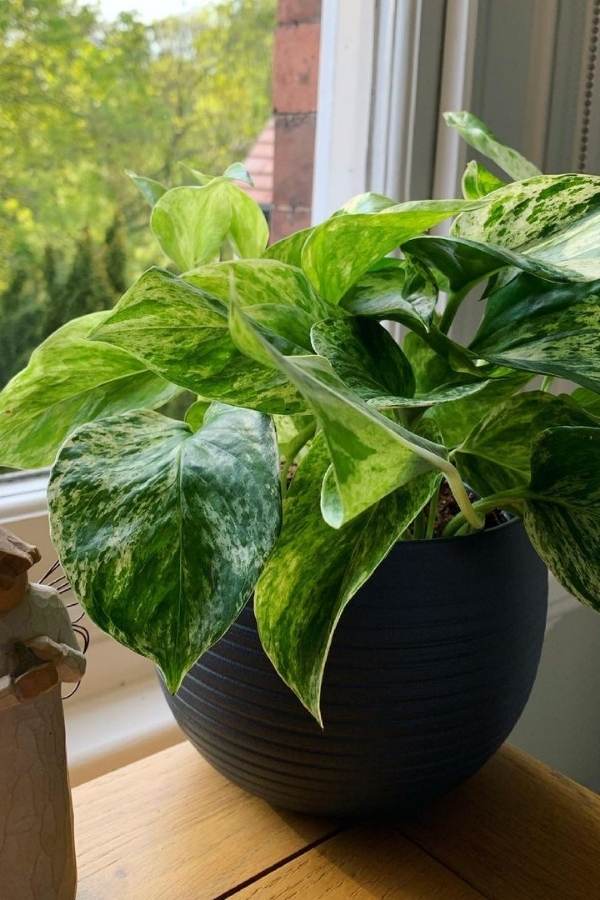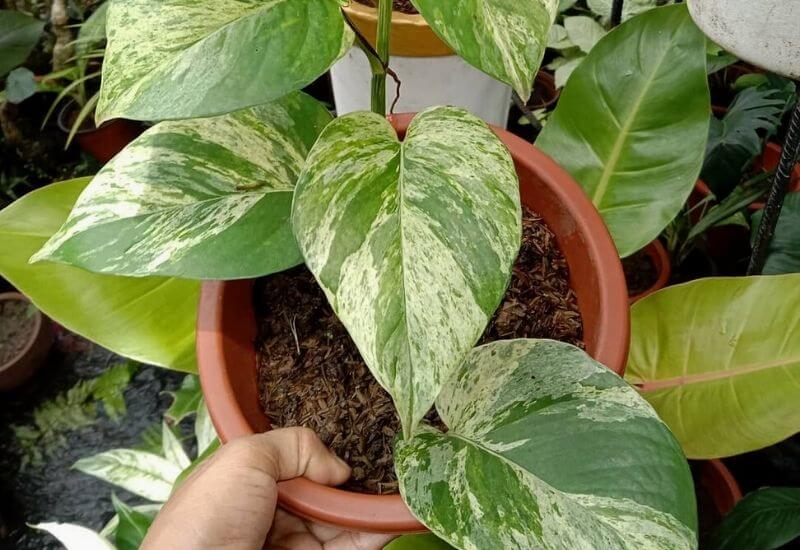
‘Marble Queen’ pothos or devil’s ivy is a cultivar of golden pothos or Epipremnum aureum; it is a well-loved tropical evergreen vine native of Mo’orea, French Polynesia.
This variety is both exotic looking and very decorative, thanks to the stark variegation contrast of green and white in its heart shaped leaves. It is mainly a grown ad a houseplant, though it can also enjoy time outdoors.
Marble Queen pothos is an easy, low maintenance plant to care for. It is undemanding like all pothos varieties but it doe have some basic needs like:
These four are just the main growing guidelines for Marble Queen pothos. There are a few more if you want to get the best results with this houseplant, and you will find the all, in detail and with practical tips if you read on!
Marble Queen Pothos Overview
Marble Queen pothos is a very decorative plant thanks to its cream white and green leaves. The variegation and color pattern on the leaves gives it a “marble effect”, hence the name.
For this reason, marble queen pothos is more showy and eye-catching than its mother variety, golden pothos or simply the Epipremnum aureum native species.

It is one of the old, “traditional” cultivars of pothos. This makes it quite widespread in garden centers all over the world and so easily available. It is in its turn the mother variety of other cultivars, like ‘Pearls and Jade’.
Devil’s ivy plant has a trailing habit, with the waxy looking heart shaped (cordate) leaves that can reach about 4 inches in length (10 cm). The overall appearance is very exotic looking but also sculptural thanks to the patterns on the leaves.
The green color can vary according to a series of factors, mainly light. It can go from light emerald green to darker shades of the same color. The white patches are mire stable in color; they are cream white at all times.
Marble Pothos plant has a slightly slower growth rate than golden pothos. This is due to its reduced quantity of chlorophyll due to the white patches. However, when adult, the vine can easily surpass 10 feet in length (3 meters).
It can also be used as a crawling plant, or carpeting, in large pots or very warm climates. What is more, marble queen pothos is very suitable for simple hydroponic growing (like a bowl, vase, jug etc. with some water in it).
Finally, this Marble Pothos is excellent to purify air, It cleanses it from general pollution but also, in particular, from toxic gases that solvents in paint give off, like formaldehyde. this makes it ideal for closed spaces and in particular newly redecorated rooms.
Having said this, marble queen pothos is poisonous if ingested and particularly dangerous to children and pets. It is not usually fatal, but it can be!
Marble Queen Pothos Fact Sheet |
Botanical name: Epipremnum aureum ‘Marble Queen’ |
Common name(s):‘Marble Queen’ pothos, marble queen pothos, marble queen devil’s vine, marble queen taro vine, marble queen devil’s ivy, marble queen money plant, marble queen hunter’s robe, marble queen ivy arum, marble queen Ceylon creeper and marble queen Solomon Islands ivy. |
Plant type: Tropical evergreen perennial vine. |
Size: It will grow to about 10 feet in length easily (3 meters). The mother species in its natural environment can reach 66 feet (20 meters)! |
Potting soil: Generic soilless potting soil (peat or compost based). |
Outdoor soil: Not suitable for full soil growing. |
Soil pH: 6.1 to 6.5. |
Light requirements indoors: Medium and indirect light to fairly weak indirect light. |
Light requirements outdoors: Keep it away from direct light, give it plenty indirect light. |
Watering requirements: Wait for the soil to dry up before watering. Do not overwater. |
Fertilizing: Moderate to scarce, every 2 to 3 months |
Bloom time: It will not flower if cultivated, only in its natural environment, at any time. |
Hardiness: USDA zones 10 to 11. |
Place of origin: The cultivar’s origin cannot be traced. The mother species is from Mo’orea, Society Islands, French Polynesia. |
A Step By Step Guide To Marble Queen Pothos Care
You have the facts about marble queen pothos; you have the basic rules for its maintenance. Now you are ready to go through all the detailed care guidelines for this beautiful houseplant.
And thus is exactly where we are heading. Next, you will find absolutely everything you need to know to grow a healthy – and beautiful! – marble queen pothos.
Light And Sunlight Requirements Of Marble Pothos

The light needs of marble queen pothos are some of the most important factors for its health. Get the light right and you are halfway there. Pothos is adaptable when it comes to light. It will survive even outside ideal conditions, but this will come with consequences, as we will see.
Marble Queen Pothos Watering Needs
Marble queen pothos is very sensitive to watering. It too is a determinant factor in its wellbeing or even survival.
In nature, comes from French Polynesia, which is on the middle of the Pacific Ocean. The area is mild, so while it is tropical, this plant is not used to downpours of water.
Here is what you need to keep in mind:
It is fairly simple, isn’t it? And even if you do forget to water your pothos, it is quite tolerant of dry periods of time. However, if you overwater it, it will likely develop rot, first in the leaves and then roots.
Marble Queen Pothos Humidity Needs
Even when it comes to humidity requirements, marble pothos is fairly adaptable. This to makes it ideal for indoors spaces and, especially, offices, where it is hard to keep stable humidity levels. Here is what you need to know.
Marble Queen Pothos Soil Requirements
Marble queen pothos has very low needs when it comes to the soil you use. Having said this, it does have some clear limitations, or needs…

All in all, as you can see, all this is easy and cheap!
Repotting Marble Queen Pothos
The best time to repot marble queen pothos is spring or summer, and it is a straightforward but delicate operation. Her is how to do it correctly.
As you can see repotting marble queen pothos requires some attention given the shape, habit and tender vines it has.
Pruning Marble Queen Pothos
Pruning marble queen pothos is simple and it can have two functions:
Here is what you need to do.
Simple. And, in case your pothos has had a very bad tome and it all looks sick, bad or even mostly dead…
Keep in mind that you can prune it back very heavily. In fact you can cut it to 2 inches (5 cm) from the soil and it will re-grow back all new and fresh.
How To Propagate Marble Queen Pothos
Propagating marble queen pothos is the easiest thing in the world. Let me show you why:
Done! In a matter of weeks, you will have a new plant.A note… though there is no season when marble queen pothos will regrow, it is best in spring to late summer when the plant is most vigorous.
How To Fertilize Marble Queen Pothos
Marble queen pothos is a plant that does not want much fertilizing. Actually you need be careful. Often overfed plants will turn spindly, change color (often go yellow) etc. So, less is more for marble queen pothos.
And here is all you need to do.
Simple and, once again, very cheap! You can even use the most generic fertilizers on the market as you can see.
Marble Queen Pothos Flowers
Pothos is a flowering plant in the wild, but it does not blossom when cultivated. Only specialists can get pothos to produce flowers, giving these plants special hormones.
Here is the problem… While golden pothos is a natural species, marble queen pothos being a cultivar and not having naturalized anywhere…
Basically it has the potential to bloom but it either never has (sigh) or if it has, it has been under spacial conditions.
We can only assume that the flowers would be similar to the mother species, which has cream spathes with purple marks and an upright spadix in the middle (a bit like peace lilies).
Having said this, people grow marble queen pothos for its leaves and not its flowers.
Marble Queen Pothos Diseases
Marble queen pothos is a very string and healthy plant, almost disease free. This too makes growing it a pleasure, but occasionally, it can get some ailments. However there are some that do happen, and you need to know about them.
Bacterial leaf spot
Bacterial leaf spot is a fungal infection and it can be quite serious with marble queen pothos.
It appears as brown spots on the leaf which then spread, and often have a yellow ring around them. It is very contagious and it can spread fast.
If not checked, it can kill your marble queen pothos. It is caused by overwatering and excessive humidity. You need to act fast. You will need to cut off the worst affected parts of the plant.
Make sure you sterilize the blade before and after, or you will spread it. Then treat it with neem oil or a solution of a tablespoon of baking soda, half a tablespoon of vegetable oil and a teaspoon of liquid soap in 2 liters of water.
Nutrient Toxicity Happens When You Overfeed Your Marble Queen Pothos
It often results in excessive growth accompanied by weak stems and leaves, spindly plants, yellowing of leaves and change of color in general. There is no actual cure, but you may need to cut down the pothos as much as possible if the situation is bad, and then repot it changing as much of the potting soil as possible.
Pythium Root Rot
Pythium root rot happens when the plant’s roots start rotting due to a bacterium called Pythium.
This is serious too and it can lead to the death of your plant. You will notice unhealthy yellowing of the leaves, which then start rotting.
You may also notice browning and rotting at the base of the stem. This too is caused by overwatering and excessive humidity.
Uproot the plant as soon as possible and check the roots.
Cut any unhealthy roots. Cut generously too. Then sprinkle the roots with organic sulphur powder. Also prune any unhealthy leaf and stem. Leave the plant out for a day and then repot in new soil.
Stem Rot
Stem rot is another type of rot, caused by a fungus called Rhizoctina. It appears as rotting of the stem, especially at the base of the plant.
It will turn brown and unhealthy. However, most people notice it when the leaves droop and lose color, which is often too late. If caught in time, your best chance to save the plant is to treat it with a strong natural fungicide like neem oil. This is, after you cut as much of the affected plant as possible.
If it is too late, you may need to take a stem cutting and start over with new plant.Having said this, all these diseases are rare if you treat your plant well, and if you follow our guidelines, they should nit trouble your marble queen pothos.
Frequently Asked Questions And Answers
As we said, marble queen pothos is a vintage cultivar, and people have been asking questions about it for many years. So here are the most common, and with full answers too!
Can You Grow Marble Queen Pothos Outdoors?
The answer is yes, you can grow marble queen pothos outdoors, but not in the ground. You can have it in pots, hanging baskets or containers. Also, you will need to take it in during winter or as soon as the temperature drops to 55oF (13oC) unless you live in USDA zines 10 or above.
How Can You Keep The Leaves White?
Keeping the white in the leaves of marble queen pothos is the key skill. It all depends on light exposure. If you give it too little light, your marble queen pothos will need food. As you know, plants use light to produce their own food…
And how do they do it? They use chlorophyll… And it is green… So, the plant will turn part of the white parts to green to eat, basically.
So, as soon as you see that the white is turning slightly green, you know your plant needs extra light. Just change its place or if you can’t, use an LED grow light. They are cheap and perfect for the job.
Do You Need To Fertilize Marble Queen Pothos If You Grow It In Water?
Yes you do need to fertilize your marble pothos with a balanced fertilizer every 4 to 6 weeks. Actually hydroponic pothos is so common that you can find specific fertilizers for your “vine in a jug”. Or you can use those for philodendron, a relative of out plant and that people grow in water too.
Should I Clean My Marble Queen Pothos Leaves?
Indoors they may get dusty, so you may need to clean them. To be honest, pothos does not collect as much dust as other houseplants with rich foliage…
Still, if it does, do not use any chemicals at all. They are not furniture and using “leaf polishing” products is really a bad habit. You actually stress the plant by doing so and plants are very susceptible to stress.
Just take a bowl of clean lukewarm water. Then take a soft cloth. Dip it in the water and gently dab the leaves. That’s the best cleaning method for foliage ever.
Does Marble Queen Pothos Attract Insects And Bugs?
No it does not! Bugs and insects are indifferent to this plant. The main reason is that it does not bloom, but it might also be that it is poisonous (to mammals, at least) and that it is not a local plant…
Can Marble Queen Pothos Be Naturalized?
It is almost impossible that marble queen pothos will ever naturalize in the Americas or Europe. So far it has not naturalized anywhere else either that we know of.
However, the mother variety, golden pothos has naturalized but only in Southeast Asia, Australia, the West Indies and some Pacific Islands.
This tells us that to naturalize it wants a very particular type of climate. It’s a funny plant. It is easy to grow but it will not flower nor naturalize easily… It has a strong personality.
But where Epipremnum aureum has naturalized… It has become a bit of a problem at times, as it can even turn invasive…
Marble Queen Pothos – More Than The Plant You Forget On The Shelf
Marble queen pothos is a wonderful plant. It ticks all the boxes of the perfect houseplant: beautiful, healthy, vital, flexible and very low maintenance. And this is why people tend to forget it on top of a shelf.
If you grow one, however, well – yes, it does not mind being left on its own for a week or two, even three id you really have to, but please do give it the little care it needs and it will repay with beauty and energy galore!

Written By
Adriano Bulla
After many years as an academic in London, Adriano Bulla became a writer, publishing books like A History of Gardening, Organic Gardening and Elements of Garden Design; he then decided to become a gardener, following his childhood dream, and has been following his dream writing and gardening professionally in Southern Europe, where he has specialized in new and innovative organic gardening fields and techniques, like permaculture, regenerative agriculture, food forests and hydroponics.

